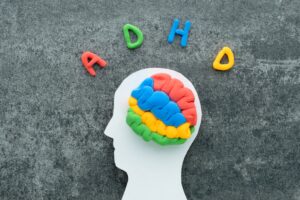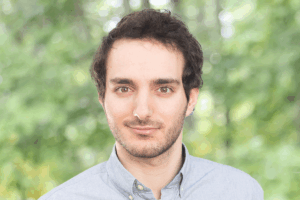While often treated as discrete diagnoses, ADHD, OCD, and anxiety frequently coexist, creating complex clinical presentations that can obscure accurate diagnosis and complicate effective treatment planning. In a recent episode of the Fear Less podcast, Mountain Valley Executive Director and host Zack Schafer spoke with Dr. Roberto Olivardia, clinical psychologist and expert in ADHD, to examine the nuanced ways these conditions intersect and manifest in daily life.

Reconceptualizing ADHD: Beyond Attention Deficits
Attention-Deficit/Hyperactivity Disorder (ADHD) remains one of the most commonly diagnosed yet persistently misunderstood mental health conditions. The condition was recently reexamined in a New York Times article titled “Have We Been Thinking About A.D.H.D. All Wrong?”, in which author Paul Tough investigates its history, diagnostic controversies, and the evolving understanding of its etiology.
Dr. Olivardia emphasizes that ADHD is best understood not as a consistent inability to pay attention, but rather as a dysregulation of attention. Individuals with ADHD often shift between inattentiveness and hyperfocus depending on the level of external stimulation. The ADHD brain, as he explains, is chronically under-stimulated, which may lead to difficulties engaging with routine or mundane tasks while fostering intense focus on activities perceived as novel or rewarding.
This tendency to seek stimulation can present in ways that are frequently mischaracterized. A child who disengages from a classroom lesson but becomes entirely absorbed in a video game may not be “unmotivated” but instead responding to internal neurological cues related to stimulation and reward.
Impulsivity, Hyperactivity, and Executive Function Challenges
In addition to attention dysregulation, ADHD is marked by significant difficulties with impulse control and executive functioning. Dr. Olivardia describes the ADHD brain as often acting before thinking, leading to challenges in self-regulation, decision-making, and task completion. This may present behaviorally as interrupting others, seeking immediate gratification, or engaging in high-risk behaviors.
Importantly, hyperactivity is not uniform across individuals. Some exhibit observable physical restlessness, while others experience internal hyperactivity in the form of racing thoughts and cognitive overstimulation. Both forms can undermine focus and create barriers to sustained engagement.
Deficits in executive function—a set of cognitive processes responsible for organizing, initiating, and completing tasks—are particularly impactful. These impairments can disrupt functioning across virtually all life domains, from maintaining self-care routines to managing relationships, academic responsibilities, or occupational tasks.
Co-Occurrence and Diagnostic Overlap with OCD and Anxiety
Although ADHD is classified as a neurodevelopmental disorder, it often co-occurs with anxiety disorders and OCD. All three involve dysregulation of thought and behavior, though their mechanisms differ. OCD is characterized by intrusive thoughts and compulsive behaviors aimed at reducing distress, while anxiety often involves persistent worry about future events or perceived threats.
Dr. Olivardia explains that the under-stimulation characteristic of ADHD may lead individuals to experience discomfort, which they attempt to alleviate through compulsive actions or obsessive thinking patterns. This may resemble or exacerbate symptoms of OCD or anxiety, even when the root cause lies in the neurological underpinnings of ADHD.
Moreover, emotional dysregulation—common in ADHD—can intensify anxiety. When individuals with ADHD struggle to manage emotional responses, they may experience heightened states of overwhelm, prompting reactive behaviors that resemble compulsions or fuel obsessive thinking.
This overlap is particularly pronounced in children, where undiagnosed ADHD may initially be misattributed to anxiety or OCD. As children encounter consistent difficulties with focus, time management, or organization, they may become increasingly anxious or develop compulsive behaviors to manage the resulting stress.
A Comprehensive Approach to Treatment
Dr. Olivardia advocates for an integrated treatment approach that combines medication with behavioral interventions. While stimulant medication is often effective in addressing the neurochemical aspects of ADHD—namely by increasing dopamine availability—it is not sufficient as a standalone intervention.
Both Dr. Olivardia and Paul Tough emphasize that although medication may mitigate distractibility and behavioral impulsivity, it does not inherently improve life functioning. Skills-based interventions remain essential. Cognitive-behavioral therapy (CBT), ADHD-specific coaching, and structured organizational systems provide individuals with practical tools to manage daily challenges. These may include breaking tasks into smaller, manageable parts, using external reminders and calendars, or establishing consistent routines.
Dr. Olivardia underscores the importance of understanding ADHD not solely as a deficit, but as a form of neurodiversity. The traits that make the ADHD brain prone to distraction or impulsivity are often the same traits that support creative problem-solving, innovation, and entrepreneurship. Recognizing and embracing this duality is key to helping individuals leverage their strengths.
Harnessing Stimulation for Creative and Productive Expression
A core feature of ADHD—the drive for novelty and stimulation—often leads individuals toward creative outlets. Dr. Olivardia notes that individuals with ADHD frequently find success in domains that reward innovation and spontaneity, such as music, visual art, or entrepreneurial ventures.
Reflecting on his own experiences, he describes inventing games as a child as a strategy for self-regulation and stimulation. For many, these activities are not simply hobbies but essential mechanisms for managing their neurological needs. When individuals with ADHD are supported in identifying and pursuing these interests, they often develop adaptive pathways for navigating the world in ways that are personally meaningful and professionally rewarding.
Moving Toward Nuanced Understanding and Tailored Support
The intersection of ADHD, OCD, and anxiety demands a nuanced approach to both diagnosis and intervention. Accurate assessment must account for overlapping symptoms and the ways in which ADHD may obscure or amplify other psychiatric conditions.
Understanding the core mechanisms of ADHD—particularly attention dysregulation, executive dysfunction, and emotional reactivity—can help reduce stigma and facilitate more effective, personalized care. As Dr. Olivardia’s work demonstrates, the path forward lies not in reducing individuals with ADHD to a set of deficits but in acknowledging their complexity and cultivating the conditions in which they can thrive.


